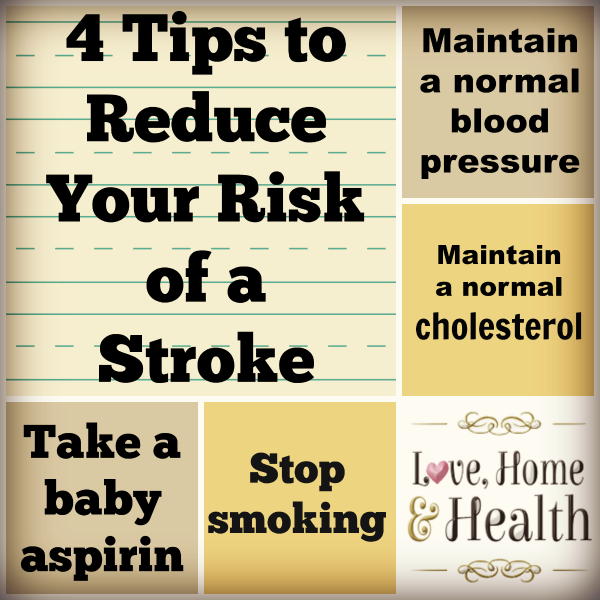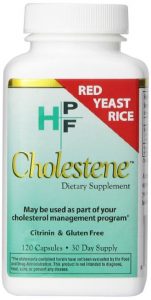The possibility of strokes is a very scary one! I sure don’t want to be an invalid and a burden to anyone – so I’m constantly researching to find ways to avoid a stroke. Today I’m sharing the Internet Stroke Center‘s 4 tips to reduce your risk of a stroke and I hope you’ll share this post with your friends and family.
The NOT So Good Statistics
Each year – over 700,000 people suffer a stroke. Five hundred thousand of those strokes are first occurrences – while the rest are repeat strokes. Every 45 seconds – someone has a stroke in the United States. YIKES – not good numbers AT ALL.
SO what can we do to prevent ourselves and immediate family from having a stroke? There are several things that could make a major difference.
There are 3 main factors that cause strokes. They are high blood pressure, diabetes and smoking. ALL of these can be avoided.
3 MAIN TYPES OF STROKES
There are 3 main types of strokes. Thrombotic, Embolic and Hemorrhagic.
A Thrombotic stroke is where plaque builds up on the arterial walls leading to the brain. The plaque eventually narrows the blood vessels and clots can form in the narrowed areas – causing a reduction in oxygen and blood flow to the brain. SO you have a Thrombotic stroke. About 70-80% are Thrombotic strokes.
An Embolic Stroke is a stroke in which there is a blood clot somewhere in the body- usually in a heart valve – and that clot breaks off and travels through the blood stream and cuts off the circulation to an area of the brain – causing an Embolic stroke.
A Hemorrhagic stroke is where – instead of blood supply being blocked – a blood vessel in the brain opens up and causes bleeding within the brain. This is caused by weakened blood vessels or can even be caused by an aneurysm in the brain that just opens up and starts bleeding. To ME? This is the scariest kind of stroke. Because it seems to me through all my research – that we can do things to thin our blood if needed – and restore the artery walls to some degree through diet – and prevent the other two. But this one seems like it would be more likely to be bad IF we were doing things to thin our blood. It’s always something – isn’t it?
We need a smooth blood flow through our arteries to carry the red blood cells that deliver the oxygen our body needs – to nearby cells. That blood that flows through our arteries is also delivering water, nutrients and minerals that are SO needed by all the cells in the body. AT THE SAME TIME – it’s removing excess waste material. An interruption of blood flow has very serious consequences because every cell in the body needs oxygen, water, nutrients and minerals to survive and thrive.
What You Can Do To Reduce Risks For Stroke
A stroke is a condition that falls under the umbrella of heart disease. And most people just really don’t realize we can be doing things to lower the possibility of us having a stroke.

Prevention Of Stroke
There are different ways to help prevent a stroke depending on the type of stroke you are trying to prevent. There are ALSO some things you can do that prevent a certain type of stroke but that has the potential to worsen another type of stroke. THIS is where it gets tricky!
The following are some things you can do to prevent a stroke:
- Maintain a normal blood pressure – This holds true for all kinds of stroke. If your blood pressure is too high, it contributes to arterial spasms and increases the risk of thrombotic stroke. If the blood pressure is too high, it can push the blood clot in the heart – from the heart valve into the circulatory system of the brain, resulting in an embolic stroke. In a completely different way, high blood pressure can cause hemorrhagic strokes. If there is a weakness in the walls of any part of the brain’s circulatory system, high blood pressure can cause that weak area to open up, resulting in the kind of bleeding you see in a hemorrhagic stroke. And did you know – an unsteady blood pressure – and that’s just it being too high now and lower later and going up and down – THAT is what weakens the walls of the arteries and causes an aneurysm. OH DEAR ME!!!
-
Maintain a normal cholesterol – Cholesterol is what makes up part of the plaques that contributes to getting a thrombotic stroke. If you maintain a good level of cholesterol, the plaques don’t build up so much and the chance that a blood clot can form in the arteries is much less. You can keep a good cholesterol level by eating food that is low in cholesterol or by taking medications designed to lower the cholesterol level. Geezer takes Red Yeast Rice for his cholesterol because he can’t take statins. And it brought his cholesterol down from about 275 to about 220. But we’ve just recently increased his Red Yeast Rice to see if it will bring it down more.
- Stop smoking – Smoking has the potential to raise your blood pressure, increasing the risk of all kinds of strokes. Smoking also contributes to plaque formation in the walls of the blood vessels so that the risk of thrombotic stroke increases. The longer you smoke, the greater is the risk of developing all kinds of heart disease, including that of thrombotic stroke.
- Take a baby aspirin – Baby aspirin is a commonly used medication used to prevent the recurrence of a heart attack in a patient who has already had a heart attack. Aspirin is a platelet inhibitor, which means that it blocks platelets from sticking together and forming a blood clot. This same phenomenon can work in the prevention of both thrombotic strokes and embolic strokes. If the platelets cannot form a blood clot – it will prevent a blood clot from forming on a heart valve so that it can’t travel to an area of the brain – leading to an embolic stroke. ALSO – when platelets are blocked from forming a clot inside a narrowed area of the blood vessels leading to the brain – this thwarts the onset of a thrombotic stroke. I also found in my research in several places that aspirin to prevent stroke is more beneficial if we take it late in the evening.
Stroke Statistics In The United States
- Stroke is the 3rd leading cause of death in the United States
- There are about 795,000 strokes every year
- Someone suffers a stroke every 40 seconds of each and every day in the US
- Stroke is the leading reason for serious disability overall – and those who survive are often left with paralysis and speech impairment causing long term disability – often requiring long term care
- After the age of 55 years old – the risk for stroke doubles every decade
- Almost ¾ of all strokes occur in people age older than 65
(Data source: Internet Stroke Center)
Living a healthy lifestyle so that the blood pressure is reduced, smoking is not a problem, and cholesterol is kept within normal levels will go a long way toward reducing the incidence of all kinds of strokes.
If you are concerned about stroke, or any type of heart disease it is a great idea to see your doctor and get a full physical and relevant screenings to be sure that there is not more that you can do to ensure you remain in optimal health.
